Common pipistrelle / Soprano pipistrelle / Nathusius’ pipistrelle / Noctule / Leisler’s bat / Daubenton’s bat / Natterer’s bat / Brown long-eared bat / Serotine / Barbastelle / Other species
Common pipistrelle (Pipistrellus pipistrellus)
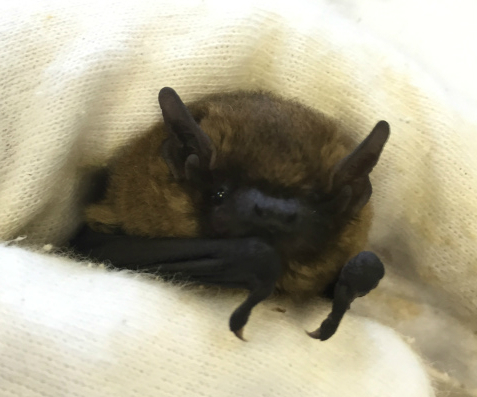
Identification: Our smallest bat with a weight of about 4-6 grams and a wingspan of 19-25cm, it is small enough to fit into a matchbox. Fur is uniform brown and the face and ears are dark brown/black. Flight is fast and erratic with lots of twists and turns.
Habitat: Often seen feeding in woodland, parks, over water, along hedgerows and even over gardens in almost every part of London.
Food: Eats small flying insects such as midges and mosquitoes. Catches and eats its food on the wing.
Roost preference: Mostly roosts in houses, under eaves and soffit boards which means their roosts are found more often than other species.
Where to look: Common across Greater London.
Soprano pipistrelle (Pipistrellus pygmaeus)
Identification: Similar to common pipistrelle, but with a slightly bigger wingspan of 18-28cm. The facial skin is also paler. Flight is erratic with twists and turns.
Habitat: Prefers riparian habitats but also seen at parks, woodland edges and in gardens.
Food: Eats small flying insects such as midges, lacewings, mayflies and mosquitoes. Feeds along water bodies.
Roost preference: Mostly roosts in houses, under eaves and soffit boards which means their roosts are found more often than other species. Can form large maternity roosts.
Where to look: Common across Greater London, especially around water bodies.
Nathusius’ pipistrelle (Pipistrellus nathusii)
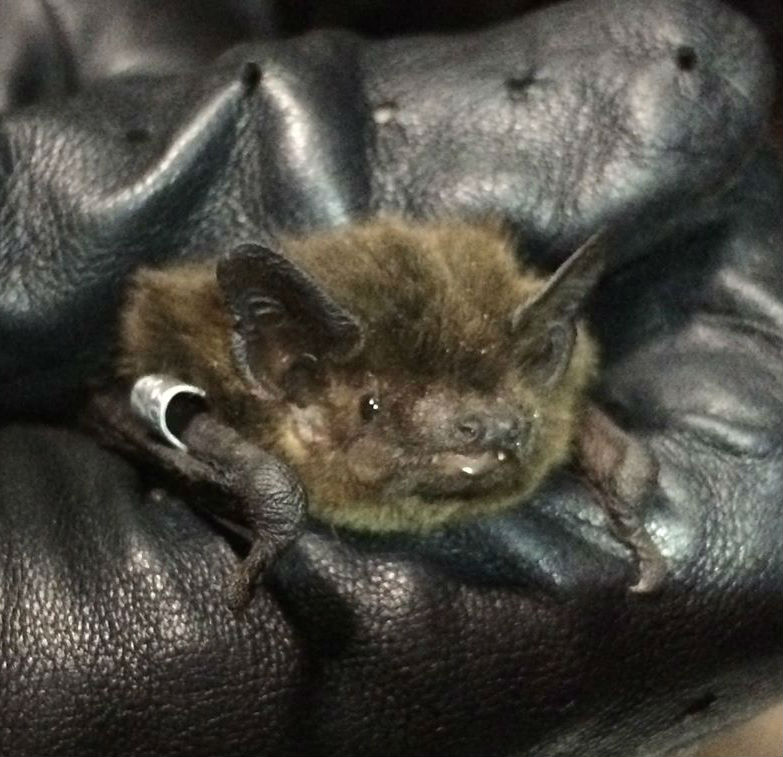
Identification: Slightly larger than common and soprano pipistrelle but still a small bat. Weighs 6-15 grams with a wingspan of 22-25 cm. Fur is shaggy and slightly paler on the belly. Flight is fast and direct.
Habitat: Found in woodland and around lakes and rivers.
Food: Feeds over the water on aquatic insects such as midges, caddis flies and lacewings. Uses aerial hawking to catch its prey.
Roost preference: Not much is known. If you think you have a Nathusius’ pipistrelle roost please get in contact.
Where to look: Can be found around large lakes. Richmond park is a good place to find Nathusius’ pipistrelle.
Noctule (Nyctalus noctula)

Identification: One of the largest bats found in Britain. It is often the first to emerge from its roost, sometimes before sunset. Weighing 18 to 40 grams, with a wingspan of 32 to 40cm, it has sleek golden fur and broad brown ears. Flight is fast and direct, high in the sky (above treetop level), with steep dives.
Habitat: Woodland, parkland and water bodies.
Food: Feeds on moths, beetles and mayflies.
Roost preference: Roosts in trees, in woodpecker or rot holes. Also found in bat boxes.
Where to look: Good sites for seeing noctule are Hampstead Heath, Berwick ponds in Havering, over the less urbanised stretches of the Thames, Oxleas Wood in Greenwich, and Hyde Park and Regents Park in central London.
Leisler’s bat (Nyctalus leisleri)
Identification: Similar to the noctule, to which it is closely related, but noticeably smaller, weighing 13-18 grams, with a wingspan of 26 to 32 cm. Flight is similar to noctule, though typically not as high (around treetop height or lower) and it performs shallower swoops after its prey rather than steep dives.
Habitat: Woodland, parkland and water bodies.
Food: Flies, moths, caddis flies, beetles.
Roost preferences: Roosts in tree holes, buildings and bat boxes.
Where to look: Leisler’s bat is widespread across Greater London and in fact the region may be one of the hot spots for this species in the UK. Good places to see Leisler’s bat include the Royal Parks, the WWT London Wetland Centre, Battersea Park and over the less urbanised stretches of the Thames.

Leisler’s bat (Philip Briggs)
Daubenton’s bat (Myotis daubentonii)
Identification: Medium sized bat weighing 7 to 12 grams and with a wing span of 24 to 27cm. It was often called the water bat in the past because of its distinctive habit of flying level about 10cm above the surface of water bodies.
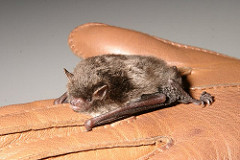
Habitat: Associated with still or slow flowing water. Also found along woodland edges.
Food: Scoops small flies such as caddis flies and midges from the water’s surface using its tail membrane and feet.
Roost preference: Found roosting in trees and bridges.
Where to look: Can be seen mainly in west London sites like Wimbledon Common; the Grand Union Canal in Hillingdon and Bushey Park, but can also be found on sites like Hampstead Heath and Beech Hill Lake in Barnet.
Natterer’s bat (Myotis nattereri)
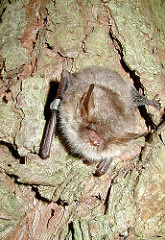
Identification: Similar in weight to Daubenton’s bat but with a slightly larger wingspan of 24 to 30cm. Flight is slow and agile, often flies along vegetation. Can also hover.
Habitat: Forages at woodland edges, open woodland and water bodies.
Food: Can use their agile flight to glean spiders, harvestman, beetles and moths from vegetation.
Roost preference: Found roosting in trees, bridges and bat boxes.
Where to look: Have been found in Highgate Woods and the grounds of Chiswick House and in 1996 a tree roost was found in Hillingdon. Work is being planned by London Underground Ltd to enhance a major autumn site for this species that has recently been found near Highgate Wood.
Brown long-eared bat (Plecotus auritus)
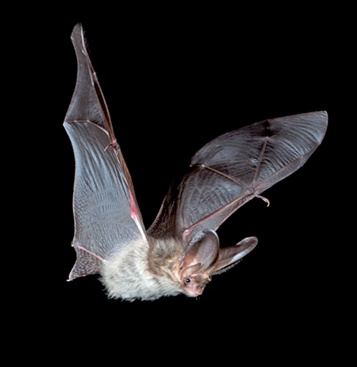
Identification: As the name suggests, the brown long-eared bat has remarkably large ears which are nearly as long as its body. It is a medium sized bat weighing 6 to 12 grams and has a wingspan of 23 to 28cm.
Habitat: Deciduous and coniferous woodland.
Food: Feeds on moths, flies and beetles. Prey is caught by gleaning off vegetation or by aerial hawking. Prey is often eaten at a feeding perch.
Roost preference: This is the bat that is most frequently found roosting inside roof spaces where it likes the ridge beams of older properties. Also found in bat boxes.
Where to look: A woodland specialist this bat can be found in and around woods. It can be a hard bat to find as it tends to emerge very late, keeping very close to trees when hunting and travelling.
Serotine (Eptesicus serotinus)
Identification: Another large bat, weighing 15 to 35 grams and with a wing span of 32 to 38cm. Flies in broad circles around trees and open areas.
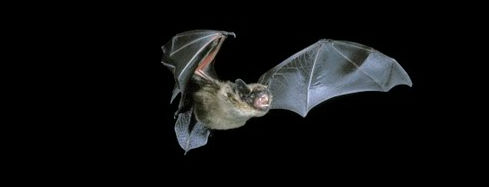
Habitat: Found foraging in pastures, mature parkland, hedgerows, suburban areas and along woodland edges.
Food: Feeds on flies and moths but is particularly fond of cockchafer beetles which it can catch by landing on the ground.
Roost preference: Prefers older buildings and houses with high gables.
Where to look: The serotine is mainly found in the outer boroughs of London such as Bromley, Havering and Sutton.
Barbastelle (Barbastella barbastellus)
Identification: The barbastelle is a medium-sized bat, with a distinctive pug-shaped nose and broad ears that join at the base. It weighs 6-13 grams and its wingspan is 26-29 cm.
Habitat: Typically roosts in ancient woodland and ranges widely across the landscape when foraging.
Food: Mainly small moths, some flies and beetles.
Roost preference: Mainly in trees where it roosts behind loose bark and in cavities, but also in bat boxes and more rarely in buildings.
Where to look: In 2017, static bat detector surveys revealed this rare species’ presence at Hainault Forest Country Park, thought to be the first records for Greater London since 1968. Subsequent annual records of this species at the site have confirmed its ongoing presence.
Other species
Other species of bat are occasionally found, especially in the outer London boroughs. There is one known summer roost of Brandt’s bats (Myotis brandtii) in Hillingdon otherwise this bat is extremely rare in London, and for the similar whiskered bat (Myotis mystacinus) there are only occasional individual records. There have also been single records in London of two vagrant species from mainland Europe, Kuhl’s pipistrelle (Pipistrellus kuhlii) and parti-coloured bat (Vespertilio murinus).
Find out more:
Download our Bats of London handout
References:
Richardson, P. (1985) Bats. Whittet Books, Great Britain.